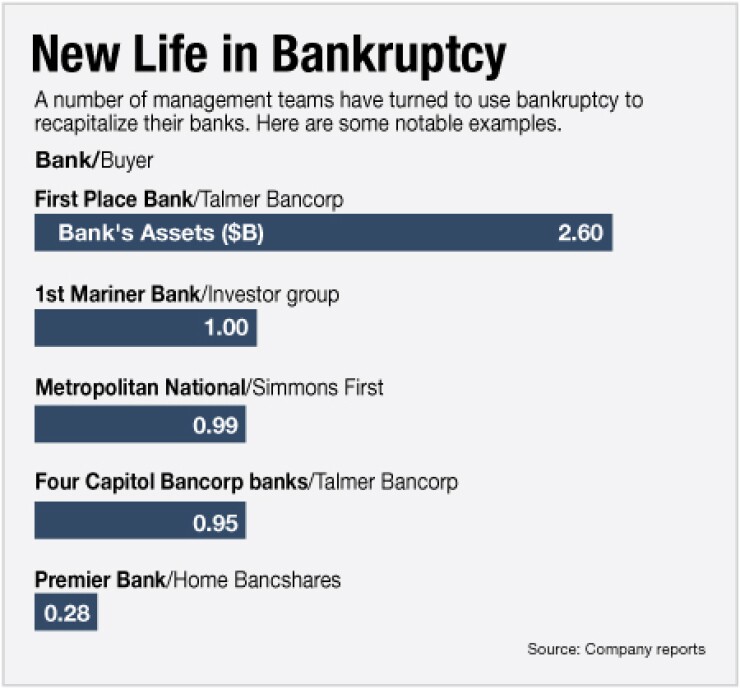-
First Mariner Bancorp (FMAR) in Baltimore is planning a $100 million recapitalization of its bank led by a group of investors.
February 10 -
First Mariner Bancorp said it had called off plans to sell a minority stake in itself to Priam Capital Fund I after determining that it could improve its capital levels with retained earnings.
November 15 -
First Mariner Bancorp in Baltimore said Thursday that it has reached an extended deadline for a proposed recapitalization by a New York fund.
September 22 -
First Mariner Bancorp (FMAR) in Baltimore recorded a large third-quarter loss after its mortgage revenue fell by more than 80% from a year earlier.
November 8 -
Rarely is bankruptcy court a welcome detour, but more struggling banks may take it to overcome debtholders blocking their recapitalization efforts.
January 5

Bankruptcy within banking used to be uncharted water, but the drastic measure is starting to look like the only way for some institutions to reach dry land.
First Mariner Bancorp (FMAR) in Baltimore said Monday that it
First Mariner has been looking to right itself for several years, but Mark Keidel, the $1 billion-asset company's interim chief executive, says the need for a solution amplified at the turn of the year. That is when the company hit its five-year deferral period on $52 million of trust-preferred securities.
"Everything was due and payable," Keidel says. "With the event of a default looming, we were concerned with the uncertainty it would create."
Given the default and the continued stress at the bank, Keidel said First Mariner's board decided that bankruptcy "was the best solution at hand."
In the years immediately following the 2008 economic downturn, some industry lawyers touted bankruptcy as a way to address issues at struggling banks that were not at immediate risk of failing. The idea was to sever the banks from their insolvent holding companies. Back then, the process was largely dismissed as an unlikely solution. As the
"The number is going to increase ... because there have been more of them and the procedure is becoming standardized," says Frank Bonaventure, a partner at Ober Kaler. "Uncertainty held people back from [bankruptcy] but it is pretty well spelled out now. Bankers like certainty."
More banks are likely feeling pressure as they hit the five-year deferral mark on debt service to holders of trust-preferred securities. Directors also have to balance obligations to equity shareholders with the duties to creditors.
"It makes [bankruptcy] more likely because that the board has new duties beyond just their fiduciary duties to shareholders," says Brennan Ryan, a partner at Nelson Mullins
In a November regulatory filing, First Mariner said its deferral period would expire near the end of 2013. It could be declared in default by creditors for not paying its deferred and compounded interest. In default, the holders could demand full payment of principal. An agreement with the Federal Reserve Board bars the company paying interest.
The investor group includes Priam Capital, Patriot Financial, GCP Capital Partners, TFO Financial Institutions Restructuring Fund and local investors.
In 2011, Priam
Leading the investors are Jack Steil and Robert Kunisch, Maryland bankers who served as consultants to First Mariner until July 2013. Steil is expected to become the bank's chairman and CEO; Kunisch is set to be president and chief operating officer.
"We liked the community banking platform," Steil says. "With the right capitalization and the right lending capacity, we think we can be a leader in commercial lending and build out throughout the state of Maryland."
First Mariner could become a consolidator after dealing with credit issues and getting a consent order lifted, Steil adds.
The investors still have to be the winning bidder. As bankruptcy auctions become more common, competition has risen, especially with existing banks that can bid higher due to potential cost savings. Kunisch says the group is cognizant of that risk.
"We have the right to increase our bid," Kunisch says. "There has been a number of [banks] who have come in and looked and didn't act upon it."





